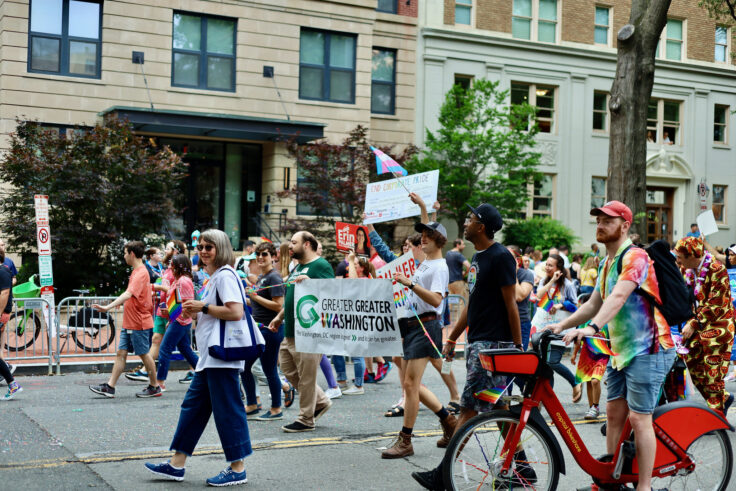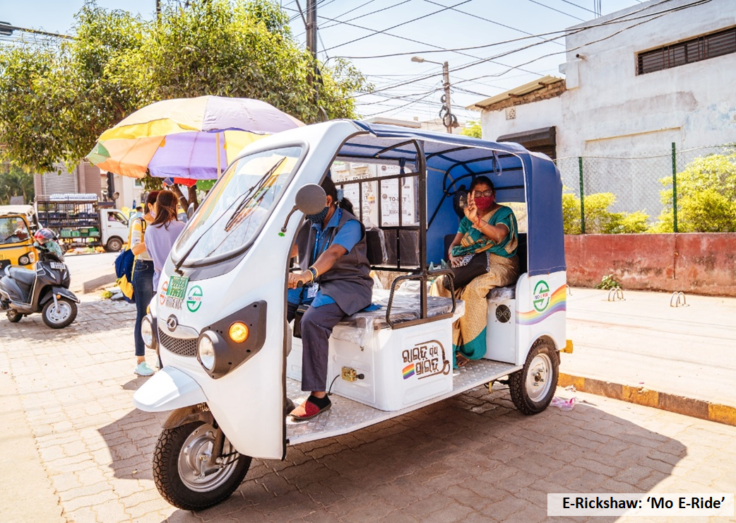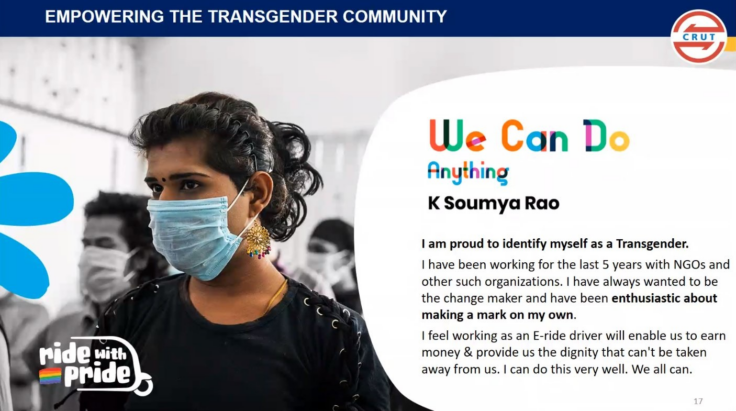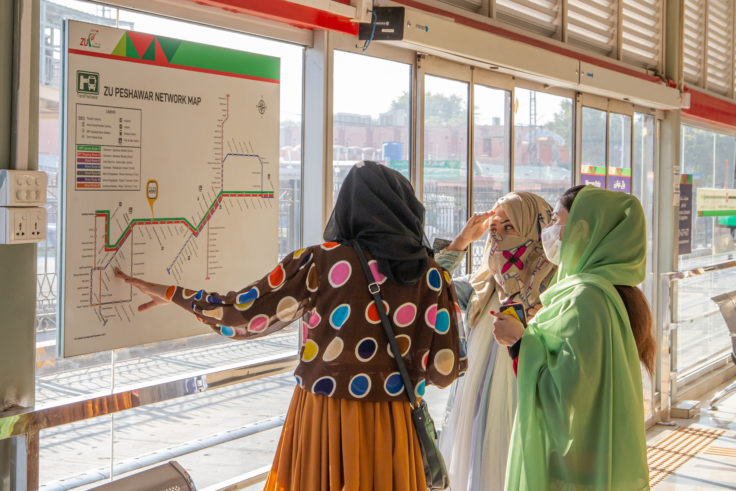March 29, 2023
Why Trans and Queer Visibility on Public Transport Matters
This piece was authored by ITDP Senior Research Associate Taylor Reich (they/them/their), based in Washington D.C.
A version of this piece also appears on Greater Greater Washington.
There are two transgender holidays. The International Transgender Day of Remembrance is honored every November 20th. It is a memorial. Practically every member of the transgender, nonbinary, and genderqueer community, myself included, knows a friend or lover who has died before their time, as is statistically likely — a victim of injustice, of hate crimes, or of a lack of (mental) healthcare. On that day, we remember them.
But Friday, March 31st is a different holiday: the International Transgender Day of Visibility. On this day, we celebrate our diversity of gender and this celebration is also a protest. For trans and nonbinary people, being visible is always a protest. Every time we dress the way we want, every time we introduce ourselves with our pronouns, every time we use the correct bathroom or impose ourselves in gendered spaces, we are risking harassment or violence in order to claim our right, one so often denied, to be ourselves in public.

Cities must actively include transgender pedestrians, bicyclists, and transport passengers through measures that are specifically designed for them.
Every act of visibility is both personal and political. We hope every act of visibility will humanize us to cisgender eyes and that all together these acts will bring tolerance, then inclusion, and then — if we celebrate this holiday for years or decades — eventually there may be no new victims to remember in November.
Moving in cities makes us visible, maybe more so than any other aspect of daily life. Walking, cycling, and riding public transport subjects us to a constant cisgender gaze, a constant threat of harassment or violence, a constant feeling that we are being seen only for our gender. This can be our greatest risk, but it can also be our greatest opportunity. Transport sets a cultural tone. If we begin to feel safe while on transport, I think, we may begin to feel safe at our destinations. But cities cannot make mobility safe for trans people by treating them like everyone else. Trans and nonbinary people cannot be asked to hide their differences. Cities must actively include transgender pedestrians, cyclists, and transport passengers through measures that are specifically designed for them.
Simply increasing the presence of police will not do the job. Police themselves are often the perpetrators of violence. They can make trans people feel less, not more, safe. More nuanced measures are necessary. These can include facilities — ensuring that gender-neutral restrooms are available in train stations, and that restrooms labeled male as well as ones labeled female stock care products like tampons. In my own city of Washington, DC, gender-neutral single-occupancy restrooms are becoming more popular.
These measures can also include operational staff — as in Bhubaneswar, India, where women and transgender people have been hired as transport drivers. And measures can include dedicated seating space on vehicles — as in Peshawar, Pakistan, where BRT buses include seats for transgender passengers. Such measures do not just make trans people safer on a particular bus; they send the message that trans people are respected and have dignity as part of society and public life.

Bhubaneswar, India
In Bhubaneswar, a city with a metropolitan population of over a million, the region’s Capital Region Urban Transport (CRUT) agency has been working to highlight safety and affordability in its transport systems while providing employment opportunities for more women and transgender people. An honorable mention for the 2023 Sustainable Transport Award, Bhubaneswar has been working to modernize and expand its bus services (Mo-Bus) with electric vehicles and a focus on passenger comfort and safety, which include new video monitoring and emergency assistance systems across its vehicles.
Notably, CRUT has also introduced a fleet of electric 3-wheelers (‘e-rickshaws’ or ‘tuk-tuks’) known as Mo E-Ride. Over the past few years, these have begun to address last-mile connectivity issues and to ensure that all commuters have multi-modal options to safely access geographies not served by the standard bus routes. All of the Mo E-Ride vehicles are also currently operated by women and transgender drivers from low-income communities that have been recruited and trained specifically by CRUT.
As a result, a 2020 rider survey conducted by the agency found an increase in reported feelings of safety amongst women commuters, given the increase in women and transgender employees in the transport workforce. Overall, commuter confidence in the region’s public transit has grown with CRUT’s renewed focus on electrification, safety, and inclusion — in fact, nearly 57% of commuters reported shifting from other modes of transport to the bus system in the past year alone, according to city officials. Learn more about Bhubaneswar’s efforts in the Sustainable Transport Award ceremony video.


Peshawar, Pakistan
In a nation where certain progress has been made on LGBTQIA+ inclusion in recent years, the City of Peshawar has been a particular pioneer in elevating the needs of women and transgender peoples in its transport planning. A Bus Rapid Transit (BRT) network, known as Zu Peshawar, was launched in mid-2020 to success, with over 50 million passengers in its first year. The city’s TransPeshawar agency earned an honorable mention from the 2022 Sustainable Transport Award program for its efforts to ensure the Zu Peshawar’s system designs engaged all types of users, with a specific focus on women, transgender people, and persons with disabilities.
Through proactive community outreach to marginalized groups, the agency also created a Gender Action Plan to act as a guideline for implementing gender-responsive accessibility, safety, and service measures. The Plan includes educational strategies to promote awareness of the rights and protections of women and transgender individuals, and offers resources for seeking assistance, such as a dedicated phone helpline. In addition, a Safe Travel program was created to specifically address issues of harassment, crime, and violence.
Other important measures include dedicated entrances for women and seats set aside specifically for transgender people on buses. TransPeshawar also set goals for increasing gender diversity on its staff and to provide regular gender-sensitivity and equity training for all employees with the aim of promoting a culture of inclusion and trust across the system. Learn more about Peshawar’s progressive inclusion efforts in ITDP’s in-depth case study.


Visibility in Daily Life
Including trans and genderqueer people also means taking action in our daily lives. For you and me, this begins in our personal relationships. One of the most important things we can do is get in the habit of introducing ourselves with preferred pronouns, even if you are cisgender. It can be a little awkward — I am often too nervous to give my pronouns when I introduce myself — but every act of visibility helps.
You can also introduce your colleagues and friends with their pronouns. In an email, for example, you can write “I have cc’d our Communications Manager, Alphonse (he/him).” At a party, you can say, “You have got to meet my friend Jamie! She uses she or they.” It can be hard to do this, and I do not expect myself to remember it every time.
But you should be sure you know what pronouns your friend actually uses first. This might mean having to go to someone you have known for years and ask them, “I am sorry I have never asked — what pronouns do you use?” It sounds a little funny, but you will send the message that transitions are normal. And you will show that you are an ally — you might even give someone an opportunity to come out of the closet.
Every act of visibility counts. Every genderqueer person riding the bus in peace, every transgender woman walking home safely, every cisgender man writing ‘he/him’ on his nametag — these are all steps towards a more free world. This March 31st, let us celebrate that visibility.
